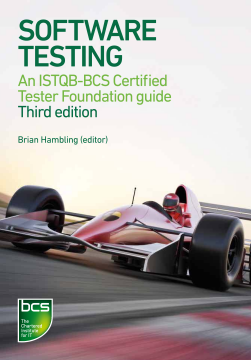
BOOK
Software Testing
Brian Hambling | Brian Hambling | Peter Morgan | Angelina Samaroo | Geoff Thompson | Peter Williams
(2015)
Additional Information
Book Details
Abstract
The best-selling software testing title is the only official textbook of the ISTQB-BCS Certified Tester Foundation Level. This third edition includes examples and exercises reflecting current technology and applications, such as the use of open source software, component-based and agile development and application building for mobile devices. It is ideal for those with a little experience of software testing who wish to cement their knowledge with industry-recognised techniques and theory.
This best-selling software testing title explains the basic steps of software testing and how to perform effective tests. It provides an overview of different techniques, both dynamic and static. It is the only official textbook of the ISTQB-BCS Certified Tester Foundation Level, with self-assessment exercises, guidance notes on the syllabus topics with sample examination questions. This third edition includes examples and exercises reflecting current technology and applications, such as the use of open source software, component-based and agile development and application building for mobile devices. It is ideal for those with a little experience of software testing who wish to cement their knowledge with industry-recognised techniques and theory.
The authors are all experienced BCS examination setters and markers and know the ISTQB syllabus in depth. The editor, Brian Hambling, has experienced software development from a developer's, project manager's and quality manager's perspective in a career spanning over 30 years.
Table of Contents
| Section Title | Page | Action | Price |
|---|---|---|---|
| Cover | C | ||
| Copyright | iv | ||
| CONTENTS | v | ||
| FIGURES AND TABLES | vii | ||
| AUTHORS | ix | ||
| ABBREVIATIONS | xi | ||
| PREFACE | xii | ||
| INTRODUCTION | 1 | ||
| NATURE AND PURPOSE OF THE BOOK | 1 | ||
| PURPOSE OF FOUNDATION | 1 | ||
| THE CERTIFIED TESTER FOUNDATION LEVEL SYLLABUS | 2 | ||
| RELATIONSHIP OF THE BOOK TO THE SYLLABUS | 4 | ||
| HOW TO GET THE BEST OUT OF THIS BOOK | 4 | ||
| 1 THE FUNDAMENTALS OF TESTING | 6 | ||
| BACKGROUND | 6 | ||
| INTRODUCTION | 6 | ||
| WHY SOFTWARE FAILS | 8 | ||
| KEEPING SOFTWARE UNDER CONTROL | 11 | ||
| WHAT TESTING IS AND WHAT TESTING DOES | 14 | ||
| GENERAL TESTING PRINCIPLES | 15 | ||
| FUNDAMENTAL TEST PROCESS | 20 | ||
| THE PSYCHOLOGY OF TESTING | 26 | ||
| CODE OF ETHICS | 27 | ||
| SUMMARY | 28 | ||
| 2 LIFE CYCLES | 37 | ||
| INTRODUCTION | 37 | ||
| SOFTWARE DEVELOPMENT MODELS | 39 | ||
| TEST LEVELS | 45 | ||
| TEST TYPES | 52 | ||
| MAINTENANCE TESTING | 54 | ||
| SUMMARY | 55 | ||
| 3 STATIC TESTING | 60 | ||
| INTRODUCTION | 60 | ||
| BACKGROUND TO STATIC TECHNIQUES | 62 | ||
| REVIEWS AND THE TEST PROCESS | 62 | ||
| STATIC ANALYSIS BY TOOLS | 71 | ||
| SUMMARY | 73 | ||
| 4 TEST DESIGN TECHNIQUES | 77 | ||
| INTRODUCTION | 77 | ||
| THE TEST DEVELOPMENT PROCESS | 79 | ||
| THE IDEA OF TEST COVERAGE | 83 | ||
| CATEGORIES OF TEST CASE DESIGN TECHNIQUES | 84 | ||
| SPECIFICATION-BASED (BLACK-BOX) TECHNIQUES | 85 | ||
| STRUCTURE-BASED (WHITE-BOX) TECHNIQUES | 100 | ||
| EXPERIENCE-BASED TECHNIQUES | 126 | ||
| CHOOSING TEST TECHNIQUES | 128 | ||
| SUMMARY | 129 | ||
| 5 TEST MANAGEMENT | 139 | ||
| INTRODUCTION | 139 | ||
| RISK AND TESTING | 142 | ||
| TEST ORGANISATION | 145 | ||
| TEST APPROACHES (TEST STRATEGIES) | 150 | ||
| TEST PLANNING AND ESTIMATION | 152 | ||
| TEST PROGRESS MONITORING AND CONTROL | 159 | ||
| INCIDENT MANAGEMENT | 165 | ||
| CONFIGURATION MANAGEMENT | 168 | ||
| SUMMARY | 169 | ||
| 6 TOOL SUPPORT FOR TESTING | 175 | ||
| INTRODUCTION | 175 | ||
| WHAT IS A TEST TOOL? | 177 | ||
| TEST TOOLS | 181 | ||
| INTRODUCING A TOOL INTO AN ORGANISATION | 212 | ||
| SUMMARY | 216 | ||
| 7 THE EXAMINATION | 223 | ||
| THE EXAMINATION | 223 | ||
| REVISION TECHNIQUES | 227 | ||
| REVIEW | 228 | ||
| APPENDICES | 229 | ||
| A1 MOCK CTFL EXAMINATION | 231 | ||
| A2 MOCK CTFL EXAMINATION ANSWERS | 245 | ||
| A3 MOCK CTFL EXAMINATION COMMENTARY | 246 | ||
| INDEX | 259 | ||
| Back Cover | 264 |
